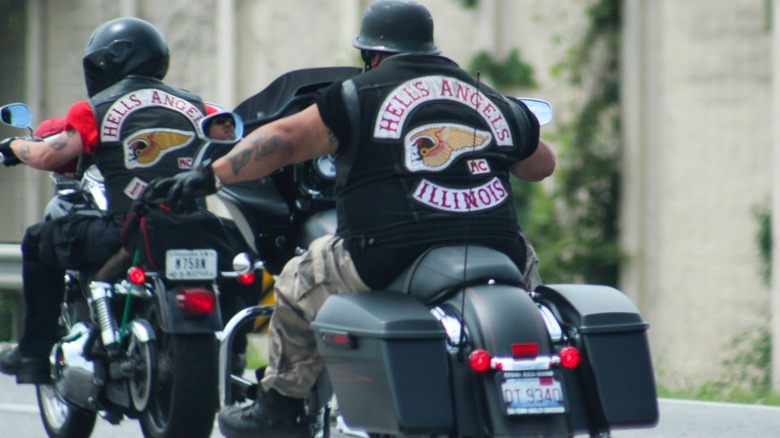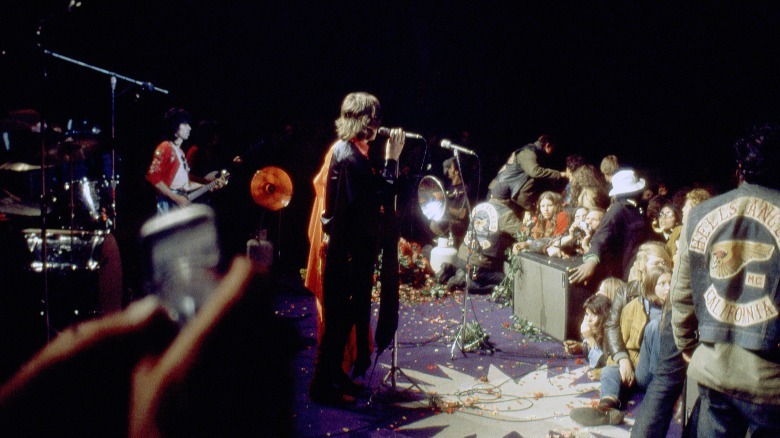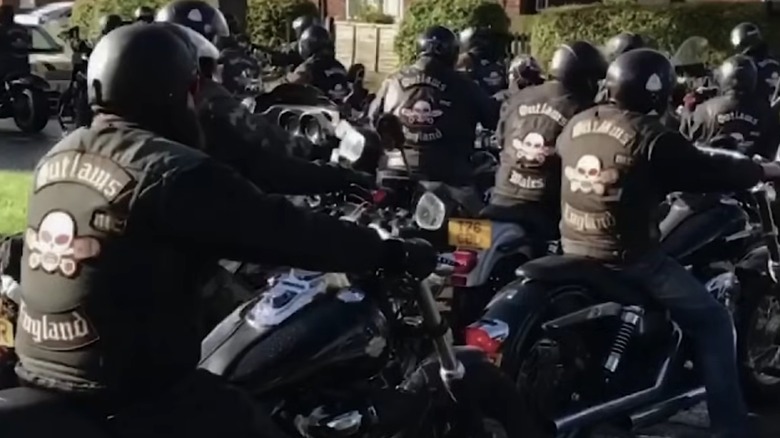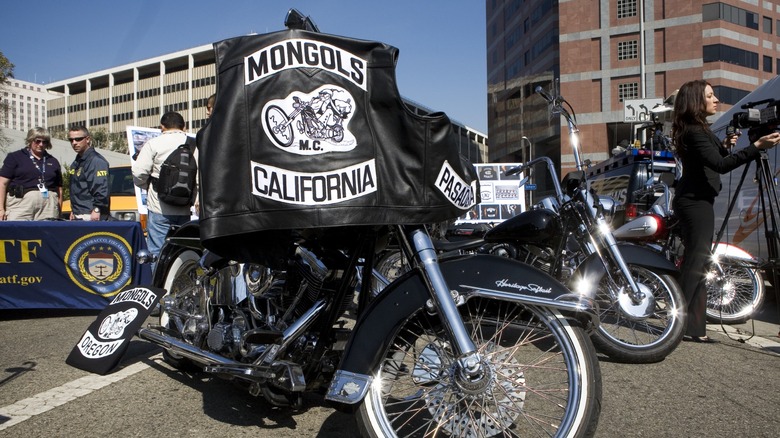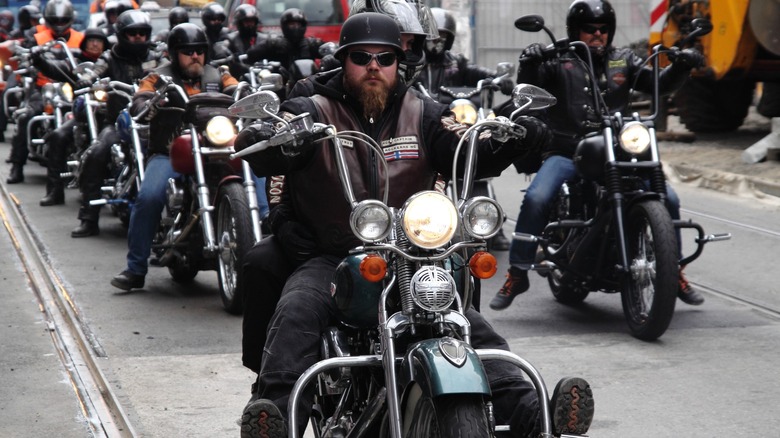6 Motorcycle Clubs Designated As 'Outlaw Gangs' By The FBI
In 1953, Hollywood legend Marlon Brando starred in the lead role of "The Wild One," a film depicting conflict in the streets between young men on motorcycles. The film was a success, introducing rogue motorcycle gangs to the public and tarnishing the image of motorcycles for generations. Although fictional, a real 1947 event in Hollister, California inspired the film.
In response to a LIFE magazine article on the riots, the American Motorcycle Association published a statement asserting that motorcycle riders are ordinary people only one percent of riders are criminals. In response, gangs adopted the label, branding themselves "One Percenters." Mostly formed by former WWII soldiers who returned home deeply scarred both physically and mentally from battle, these Outlaw Motorcycle Gangs (OMG) provided camaraderie and often nefarious employment opportunities when nobody else would.
Today, the Department of Justice, of which the Federal Bureau of Investigation (FBI) is a part, claims that more than 300 OMGs exist and that they use legitimate motorcycle clubs as structured organizations to facilitate organized crime involving drugs, weapons, extortion, prostitution, and other rackets, all frequently accompanied by extreme violence. These groups pose a significant danger to the public and continue to be a focus of law enforcement. They have a global reach and proudly display their affiliations, often having official websites for the clubs' legal activities. However, illegal activity often rests just below the surface and is likely closer than you think. Clubs range in size and scope, but these six are among the largest and most notorious in America.
Hells Angels
If you have heard of just one OMG, it is likely the Hells Angels. They are often mentioned in pop culture and depicted in works of fiction on the page and screen. They also gained infamy after being hired by the Rolling Stones to provide security for the crowd of up to 300,000 people at the 1969 Altamont Free Concert, resulting in multiple assaults and the death of a young concertgoer. The legendary journalist Hunter S. Thompson, who is known for creating gonzo journalism by immersing himself as a participant in the story, rose to fame with his book, "Hells Angels: The Strange and Terrible Saga of the Outlaw Motorcycle Gangs." The "biker film" genre of the 1960s is also directly influenced by the Angels, with their culture on display in films such as "Easy Rider," "The Wild Angels," and "Hell's Angels on Wheels."
The pop culture notoriety of the Hells Angels comes from tales of real life. Formed in 1948, the club adopted its name from squadrons of bombers in WWI and WWII. Membership grew quickly, and by 1961, it had spread from Southern California all the way to New Zealand. While it became well known in the late '60s, the Hells Angels lived in relative obscurity until 1965 when the California attorney general published a report on motorcycle gangs, accusing them of "hoodlum activities." Although critics suggested he had sensationalized the report, national media picked it up and inserted OMGs, including the Hells Angels, into the zeitgeist.
Hells Angels criminality
Through the '50s and '60s, the Angels were known mostly for delinquent behavior involving barroom brawls and generally antisocial behavior. However, its nature evolved and took a turn in the '70s as the organization became more structured, mature, and professional. As its membership grew, so did its organized activities, branching out into drug trafficking. Not only did it elevate members from engaging in small-time drug peddling and street fights to large-scale trafficking and turf wars with rival gangs, it exponentially increased the collective income in tandem with levels of violence.
Hells Angels long-time president Sonny Barger, who died in 2022 at 83, once described the organization as "a bunch of fun-loving guys who just ride motorcycles," repeating a refrain from the club that news stories about them are overblown. Despite these efforts at normalization, the DoJ maintains that the club engages in the distribution of cocaine, heroin, methamphetamine, and illegal firearms. Agents from the FBI, DEA, and ATF regularly execute operations to infiltrate various chapters and take down its members with an emphasis on arresting leadership. A 2009 report by Albert De Amicis of the University of Phoenix details a sordid world of debauchery and wanton violence in which the Angels' involvement in organized crime, including multiple murders, poses an extreme danger to the public.
Despite its attempt at keeping a rosy public image, including maintaining an official club website, its indifference to the effects of its activities should give everyone pause.
Pagan's MC
Established in 1959, the Pagan's Motorcycle Club took hold in Maryland and asserted itself as the dominant club of the East Coast, with concentrations in Pennsylvania, Delaware, Maryland, and New Jersey. Unlike other OMGs, Pagans have no static home base, instead meeting at rotating houses of members due to changes made in response to a 1983 RICO investigation. However, they are still dedicated to protecting their territory and view other OMGs, particularly the Hells Angels, as a hostile threat when crossing territorial boundaries. Pagans have a heavy presence in the southern part of New Jersey, and when Hells Angels started setting up shop in the northern counties, violence ensued.
Requirements to become a Pagan are simple but strict and not unlike those of other OMGs. Candidacy is only open to males of at least 18 years of age who own a Harley-Davidson motorcycle with an engine size of 900cc or greater, although they must be 21 to become a full member. Recruitment was once a lengthy process called "prospecting." Recruits had to endure various rounds of hazing meant to prove loyalty to the group for up to six months. However, things have changed, allowing members admission in much less time. Furthermore, the historically White-only organization now includes many former gang members of street gangs such as the Latin Kings, Crips, and Bloods, although only light-skinned Latinos are admitted and nobody who is Black. Furthermore, a membership of less than 100 has ballooned to nearly 1,000 today.
Pagan's MC criminality
You may encounter individuals proclaiming the Pagan's to be decent guys who like motorcycles. A Pagan's MC public Facebook Group, which may or may not be official, is full of comments suggesting they are generally harmless as long as you don't cross them. However, reports from various law enforcement agencies strenuously disagree, detailing a long history of organized crime, once concentrating on running chop shops before moving into methamphetamine production and trafficking. Regardless of whether they were dealing in boosted auto parts or illicit drugs, extreme violence has been a part of their culture.
While the Pagan's MC manufactured their own methamphetamines to distribute for many years, they have sourced a supply of the drug from Mexican cartels in recent years. Additionally, distribution is distributed to multiple small-scale operations, with many members unaware of its source or other details about the supply, protecting the larger group from disruptions due to actions by law enforcement. Any member placed under arrest must observe a strict code of silence.
Besides narcotics distribution, Pagans engage in extortion and work as hired muscle for select clients, and their proximity to Eastern mafia outfits provides opportunities for collaboration. Furthermore, behind all Pagan activities is a healthy supply of weapons, including firearms of all kinds and plenty of ammunition. While Pagan's MC is not the largest OMG in the country, it would be folly to underestimate how dangerous it is, and that continues to keep law enforcement agencies on alert.
Bandidos MC
Hailing from Texas, the naming of the Bandidos Motorcycle Club is fitting given the prevalence of Spanish-speaking people in that part of the country. It is further befitting given the history of border-crossing bandit raids on Texas early in the 20th century. It's as if banditry is just a part of Texas. However untrue that may be, it makes for a good story. Furthermore, the Bandidos MC would like you to believe a good story about a brotherhood of motorcycle riders linked by nothing more than a passion for the road.
Starting around 1966, dockworker Donald Chambers, bored with existing clubs he had joined, assembled riders from biker bars in the Houston area into an organization that would become the Bandidos MC. In the same manner veterans formed the original OMGs, the Bandidos saw many veterans joining its ranks, this time from Vietnam. Chambers chose the name to honor the aforementioned Mexican bandits who declined to live by society's rules in favor of their own, and he sought members who would not fit into "polite society." Indeed, among its mottos is "We are the people your parents warned you about."
Despite being subject to countless law enforcement investigations over the years, Bandidos claim to be honorable men and that people would not assume anyone with long hair on a Harley is a bad person. After all, they are non-conformists with a love of the open road who band together for camaraderie and a good time — at least, that's what they want you to think.
Bandidos criminality
While not all are inherently bad people, many Bandidos engage in some pretty despicable acts. Membership is no longer localized to Texas, as Bandidos can be found today throughout the United States and into Europe and Australia. With a worldwide membership of 5,000, not every Bandido is not a criminal, but some are.
Club founder Donald Chambers was, however, a criminal, and he was arrested in 1972 for a double homicide of drug dealers in El Paso. He and his accomplices forced their victims to dig their own graves before killing them. He received two consecutive life sentences. Later, when new members rose up to leadership, they chose to tone down the violence and focus on profits from illicit substances and other rackets. However, rivalries and turf wars remained a mainstay of Bandidos life.
A 2015 shootout at a Waco Twin Peaks restaurant between Bandidos and rival Cossacks MC left nine dead, but a lack of evidence prevented prosecution. But even more intense was the Nordic Biker War from 1994 to 1997, in which Bandidos and Hells Angels fought each other across Scandinavia, even using RPGs, grenades, and anti-tank missiles stolen from local armories and acquired from formerly Communist countries. Although Bandidos have a legal entity to manage its regular charitable contributions, and host charitable events to boost its image, the criminal element will always be there.
Outlaws MC
While many OMGs sprang up in the post-war years, the Outlaws Motorcycle Club began several years before the war in 1935 as the McCook Outlaws Motorcycle Club. It went dormant during WWII, but the same conditions that led to the formation of the Hells Angels provided the McCook, Illinois OMG a big boost in membership and activity. Upon moving the club to Chicago in 1950, its name changed to the Chicago Outlaws, and eventually just Outlaws as it expanded to other cities in the Midwest, such as Milwaukee and Louisville.
Outlaws have spread far and wide from their Chicago roots to establish chapters in 26 states and 39 other countries as diverse as Slovakia, Singapore, and Oman. International expansion saw many existing motorcycle clubs, with several called Outlaws but unaffiliated with the Chicago club, officially join the American Outlaws Association, the club's official legal entity.
As is typical with many of these clubs in the '60s, the Outlaws were generally into hooliganism and debauchery, fighting and drinking most of the time when they weren't riding. We have a rich pictorial history of this period thanks to photojournalist Danny Lyon, who joined the Outlaws at 24 years of age and embedded himself as a sort of pictorial archivist of their activities. He published a photo book documenting the Outlaws' exploits in 1968, and it inspired a film of the same name, "Bikeriders," in 2016.
Outlaws MC criminality
Being not much more than a general nuisance in the '60s gave rise to becoming something more serious, organized, and dangerous in the '70s. More violence and intimidation tactics crept into their illicit activities, and rivalries with adversarial OMGs led to further crimes and tragedy, including the killing of a 14-year-old by a bomb intended for a rival. The increased criminality coincided with a strict code of silence, making it difficult for law enforcement.
The Outlaws' criminal activities were characterized by law enforcement as a racketeering enterprise including extortion, prostitution, guns, drugs, and murder. In Florida, for example, authorities were having trouble getting a handle on the crimes committed by the Outlaws until a string of high-profile prosecutions from 1981 to 2003 took down top leaders in area chapters. The trials exposed the groups as misogynistic, racist, and violent, presenting evidence of dozens of crimes, including arson, kidnapping, robbery, and murder. Security was kept extremely high, with up to 16 U.S. Marshals in court to keep order.
While an organization this large has many members that are really just ordinary guys with jobs and businesses who like to let loose on the weekends and feel the wind in their hair, the club's motto, "God Forgives, Outlaws Don't," suggests something more ominous. The headlines of just the past couple of years feature charges of murder against an Outlaw in Maine, the killing of a witness by fentanyl overdose in Buffalo, and convictions for 20 kilograms of cocaine in Helsinki, Finland.
Mongols MC
In the heavily Latino Los Angeles suburb of Montebello formed the Mongols Nation Motorcycle Club, a largely Hispanic OMG. The club is rather intense and adheres to a rigid hierarchy along with hazing for new members and strict rules for members. To emphasize how extreme this OMG is, an undercover ATF agent who had once infiltrated the group described it as "the most violent motorcycle gang in America, a tight-knit collective of crazies, unpredictable and unrepentant badasses."
Abiding by the motto "Respect Few, Fear None," the Mongols spread like Ghengis Khan's horde from southern California across the United States and abroad. At least part of this fierce mentality can likely be linked to one of the founders who started the club upon returning from Vietnam with a full discharge from the military and numerous medals. He claims to have been involved in brutally violent actions while overseas and returned home to a world in which he no longer knew how to function properly. This led to his propensity for delivering untold violence on anyone who crossed him or not. However, "Big" Al Aceves has since turned over a leaf and is now a preacher.
Regardless of any former leaders lost to the ministry, the Mongols formed in the shadow of the growing Hells Angels in their native California, posing a threat on their doorstep. This forced the Mongols to adapt to survive, accepting members of different ethnicities and often striking deals with other gangs to survive.
Mongols MC criminality
According to former Mongol Oregon chapter leader Justin DeLoretto, tales of wild criminality and major drug operations are overblown. He said in a Business Insider interview that his chapter consisted largely of guys who just liked hanging out and riding bikes, but that rivalries with other clubs were acted upon when they crossed paths and that the violent turf wars were always a part of being a Mongol. During a federal operation in 2008, several chapters were raided, and nobody from his chapter was arrested.
While DeLoretto's characterization of his Mongols chapter is relatively benign, federal agents surveilled and infiltrated the Mongols in California for two decades, resulting in convictions for racketeering in 2018. Around the same time in Tennessee, a dozen Mongols were charged in a 54-count indictment indicating evidence of drug trafficking, robbery, extortion, and murder, including moving large quantities of methamphetamines. Even more recently, in 2024, former Marine Christopher Bingham was arrested riding with a couple of OMG members. This is not shocking until you discover that he was a Sheriff's deputy in southern California at the time and a search warrant revealed about 160 firearms, including fully automatic rifles and grenades, in his home.
No matter how positive a spin any Mongol current or past wants to put on the organization, some part of it is up to no good. Judging by police reports in areas with local chapters, that part is bigger than anyone lets on.
Vagos MC
Named for the Spanish word for Vagabond, the Vagos Motorcycle Club originated in the tumultuous 1960s and grew alongside the sexual revolution and the Vietnam War. According to the club's official website, 13 friends who loved riding motorcycles gathered on the corner of 8th and Davidson in San Bernardino, California to establish what would become the Vagos. From there, it spread and grew to other cities, states, and eventually, countries, spreading a love for riding with a penchant for violence.
Rudy Esparza, nicknamed Puro, helped select the name of the new club, and it immediately grappled with its existence as it could easily have been pushed out or absorbed by other clubs. Instead, it survived and grew into an international organization that, as of 2014, was said by the FBI to have 600 members in 24 chapters in America, with more abroad. Those numbers have surely swelled, and the club's official website lists chapters primarily in the West, with several throughout Mexico and a couple in Central America and one in Brazil.
Relatively little information about the club's culture appears online, and the website is equally as tight-lipped. However, they proudly display their emblem of a red devil riding a winged cycle wheel with a background of green flames.
Vagos MC criminality
On its face, the Vagos MC appears to be like any other club of riders who like to hang out, drink, and ride. Their website lists various events, including celebrations and campouts for members. However, perusing select samples of police blotter reveals a dark underbelly supporting the club's activities.
Law enforcement gained significant information on how the Vagos operated along with plenty of incriminating evidence thanks to the efforts of Charles Falco, who agreed to work as an undercover informant for the DEA in lieu of a 22-year prison sentence for conspiracy to manufacture and distribute methamphetamine. In his two-and-a-half years informing on the Vagos, he witnessed all manner of crimes, from bar fights to embezzlement and murder. He said they bought a great deal of guns and drugs, and helped to convict 25 members before being pulled out. Like Falco, Darrin Kozlowski also infiltrated the Vagos, but he did it as part of his job as an ATF agent. He infiltrated several OMGs, and says the Vagos are as bad and violent as any other club.
A few examples of wide-ranging arrests of Vagos in the last decade or so include the 2017 indictment of 23 Vagos members charged with multiple crimes in Nevada, including a murder at a Reno casino. Reports of numerous shootings and scuffles made the news in 2012 in Springfield, Missouri, and in 2022, six Vagos were hospitalized after a melee with Hells Angels in Las Vegas.

